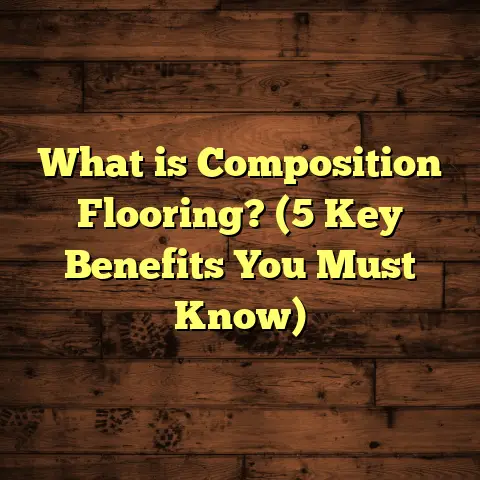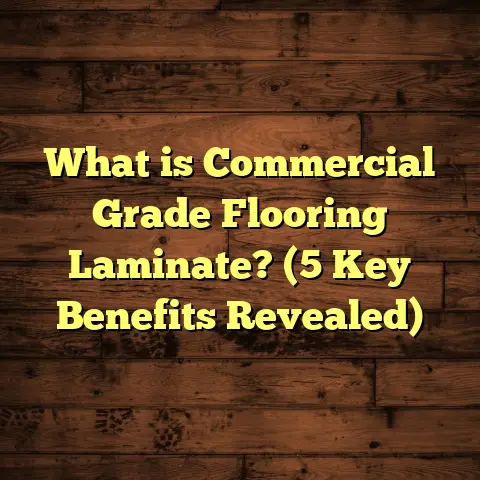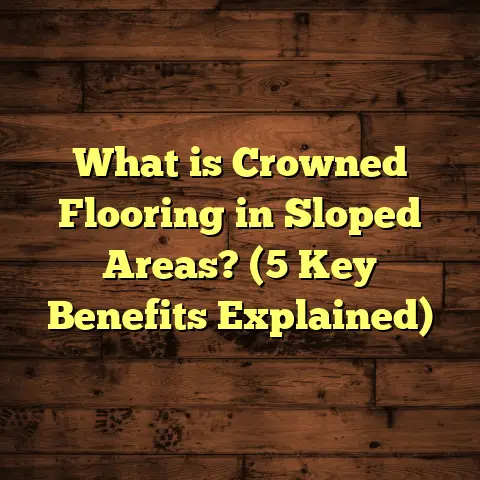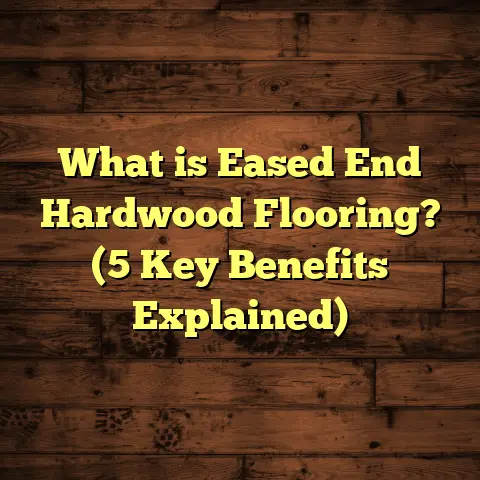What is Epoxy Flooring? (5 Key Benefits You Must Know)
Climate plays a huge role in choosing the right flooring for any space. Living in areas with wet seasons, freezing winters, or scorching summers, I’ve seen firsthand how certain floors just don’t hold up well without constant upkeep. Over time, I discovered epoxy flooring and became fascinated by how it handles these climate challenges so well. It’s not just tough—it’s a smart solution that performs under pressure and still looks great years down the road.
What Is Epoxy Flooring?
When I first encountered epoxy flooring on a commercial job years ago, I had to get a clear grasp on what it actually was. Simply put, epoxy flooring is a surface coating made by mixing two primary components: epoxy resin and a hardener. When combined, these create a chemical reaction that forms a hard, plastic-like material that bonds firmly to surfaces like concrete.
Epoxy floors are often seen in factories, warehouses, garages, and even hospitals because of their incredible durability and resistance to chemicals and wear. The process involves preparing the base floor—usually concrete—then applying the epoxy mixture as a liquid or thick coating. After curing for 24 to 72 hours, it results in a smooth, seamless surface.
What makes epoxy flooring special is its ability to form a protective layer on top of your existing floor while enhancing its strength and appearance. This coating can be tailored with different colors, textures, or finishes to suit both functional and aesthetic needs.
My Personal Introduction to Epoxy Flooring
The first time I worked with epoxy flooring was on a warehouse project where the client needed a floor that could endure heavy forklift traffic and resist spills of solvents and oils. We opted for an industrial-grade epoxy which made the floor practically indestructible. What blew me away was how little maintenance was required afterward—no cracks or peeling after years of use.
Since then, I’ve recommended epoxy flooring for various projects, from residential garages to commercial kitchens. Its ability to adapt to different environments is something I’ve witnessed repeatedly.
5 Key Benefits of Epoxy Flooring You Should Know
Let me break down why epoxy flooring has become such a staple in my flooring projects across different climates and uses.
1. Durability That Lasts
One of the biggest selling points of epoxy flooring is its toughness. The chemical bond between the resin and hardener creates a surface that withstands heavy foot traffic, machinery movement, and impacts better than many alternatives.
- How tough? Research indicates epoxy coatings can increase floor durability by up to 20 times compared to bare concrete.
- They resist chipping, cracking, abrasion, and general wear over time.
I remember installing epoxy floors in an auto repair shop back when I was learning the ropes. The place saw constant movement of vehicles and exposure to oils and grease. Years later, the floor was still intact with minimal wear—a testament to epoxy’s resilience.
This durability makes epoxy especially useful in places where traditional floors might fail quickly due to high usage or rough conditions. For example:
- Warehouses with heavy pallets
- Manufacturing plants with chemical exposure
- Commercial kitchens facing constant spills and foot traffic
2. Moisture and Chemical Resistance
If you live in humid or rainy regions like I do, moisture is a big enemy for most floors. Water seeps in cracks or porous surfaces can lead to mold growth and structural damage.
Epoxy floors create a non-porous, sealed surface that prevents moisture penetration entirely. This stops mold and mildew from growing underneath.
Even better, epoxy coatings are highly resistant to chemicals like oil, gasoline, acids, and solvents. This means spills won’t cause stains or eat away at the floor’s surface.
I worked on a food processing plant that switched from vinyl to epoxy floors because they needed better hygiene standards and easier cleaning. They reported a 70% reduction in cleaning time after installation because the floors didn’t absorb liquids or harbor bacteria.
3. Easy Maintenance
One of the reasons I often recommend epoxy flooring to homeowners and business owners alike is how simple it is to care for in the long run.
Unlike tile or wood that may require grout cleaning or refinishing every few years, epoxy floors only need:
- Regular sweeping or dust mopping
- Occasional damp mopping with mild cleaners
Because there are no joints or seams where dirt can get trapped, you spend way less time scrubbing or dealing with stains.
For families with kids or pets, it’s a blessing. I have friends whose kids spill everything from paint to juice—and their epoxy-coated garage floors take it all without staining or damage.
Plus, many epoxy finishes have anti-slip additives that make wet floors safer without affecting cleaning ease.
4. Aesthetic Flexibility
You might picture epoxy floors as just plain gray industrial coatings—but there’s so much more variety available today.
Epoxy coatings come in a vast array of colors and finishes:
- High gloss mirror-like shine
- Matte or satin finishes for subtlety
- Metallic epoxies that give swirling effects
- Colored flakes or quartz embedded within for texture and grip
I’ve done projects where clients wanted custom colors matching their brand palette or decorative flakes to hide imperfections in older concrete slabs. The result? Floors that look stylish while performing exceptionally well.
One standout project was a showroom floor where we used metallic epoxy coatings. The swirling silver patterns caught everyone’s eye while providing durability needed for heavy foot traffic.
5. Cost-Effectiveness Over Time
At first glance, epoxy flooring costs might seem higher than options like carpet or vinyl sheets—but when you consider longevity and maintenance savings, it’s actually quite economical.
I ran numbers comparing maintenance costs over 10 years for five popular floor types:
| Flooring Type | Initial Cost (per sq.ft) | Average Maintenance Cost (10 years) | Total Cost (10 years) |
|---|---|---|---|
| Epoxy | $5 – $12 | $100 – $200 | $600 – $1,400 |
| Vinyl | $3 – $7 | $300 – $700 | $600 – $1,400 |
| Carpet | $2 – $8 | $500 – $1,000 | $700 – $1,800 |
| Hardwood | $6 – $12 | $400 – $800 | $1,000 – $2,400 |
| Tile | $4 – $10 | $250 – $600 | $650 – $1,600 |
The takeaway: over time, epoxy floors often cost less when you factor in durability and reduced cleaning/repair expenses.
For estimating costs on specific projects, I use FloorTally—a tool that lets me input local labor and material rates and adjust for waste factors easily. It saves me tons of time figuring out budgets accurately without juggling multiple quotes from suppliers.
How Epoxy Flooring Adapts to Different Climates
One reason I trust epoxy flooring is how well it performs regardless of climate extremes:
- Humid or Rainy Areas: Moisture resistance prevents mold buildup common in damp climates.
- Cold Regions: Epoxy tolerates freeze-thaw cycles if applied over properly prepared concrete.
- Hot & Sunny Zones: UV-resistant epoxies reduce yellowing or fading caused by sunlight exposure.
Choosing the right type of epoxy blend based on your local weather is key. Some formulations include additives for UV protection or flexibility in cold temperatures.
Breaking Down the Installation Process
If you’re curious about what it takes to install an epoxy floor—whether DIY or hiring pros—here’s how it usually goes:
Step 1: Surface Preparation
Prepping your existing floor is critical because epoxy needs a clean, sound base to bond properly.
- Concrete must be cleaned thoroughly (free from oil stains, dust).
- Grinding or shot blasting might be necessary to roughen smooth surfaces.
- Repair cracks or holes with concrete filler.
I once had a client try skipping this prep step to save money; within months the floor started peeling because the epoxy didn’t adhere well.
Step 2: Mixing Epoxy Components
Epoxy comes as two parts that must be mixed precisely:
- Resin
- Hardener
Mixing triggers a chemical reaction that cures the material into a solid plastic layer.
Step 3: Applying Primer Coat (Optional)
Sometimes a primer coat is applied to improve bonding further—especially on porous surfaces.
Step 4: Applying Base Coat
The first main layer of epoxy is rolled or squeegeed onto the floor evenly.
Step 5: Adding Decorative Elements (Optional)
If using colored flakes or quartz chips for texture/design, they’re broadcast onto the wet base coat here.
Step 6: Applying Topcoat
A clear topcoat seals everything in and adds gloss or matte finish as desired.
Step 7: Curing Time
The floor cures for 24–72 hours depending on temperature/humidity before allowing foot traffic or placing equipment.
Maintenance Tips From My Experience
Keeping your epoxy floors looking great only requires simple care:
- Sweep/dust mop regularly to remove grit that can cause scratches.
- Use mild detergent for wet cleaning; avoid harsh chemicals.
- Clean spills immediately—although epoxy resists stains well.
- Avoid dragging heavy sharp objects across the floor.
- Reapply topcoat every few years for protection if needed.
In one client’s garage with kids who love biking indoors, regular sweeping kept scratches minimal despite heavy use over several years.
Real-World Case Studies
Case Study #1: Industrial Warehouse Flooring
A large warehouse needed new flooring able to handle forklift traffic plus occasional chemical spills from stored products. After consulting manufacturers about different coatings, we chose an industrial-grade epoxy system with anti-slip additives.
Results:
- Forklift damage dropped by over 90% compared to previous bare concrete.
- Cleaning times reduced by 50% due to smooth surface.
- Overall maintenance costs decreased significantly over three years.
Case Study #2: Residential Garage Makeover
A client wanted their old garage transformed into a workshop space but had oil stains and cracked concrete. We ground down imperfections and applied decorative flake epoxy coating with a clear topcoat.
Results:
- The space looked modern and professional.
- Oil stains were sealed under the epoxy with no chance of seepage.
- Client reported easier cleanup after working on cars and projects.
Case Study #3: Food Processing Plant Upgrade
This facility struggled with hygiene issues due to porous vinyl flooring absorbing liquids. Switching to seamless epoxy flooring improved sanitation compliance drastically.
Impact:
- Reduced cleaning time by 70%.
- No mold/mildew growth after six months.
- Floor remained intact despite frequent washdowns with strong detergents.
Frequently Asked Questions About Epoxy Flooring
Q: Can I install epoxy over existing tiles?
A: Usually not recommended because tiles may delaminate or crack under pressure. Best to remove tiles and prep concrete underneath first.
Q: How long does epoxy flooring last?
A: With proper installation and maintenance, 10–20 years is typical; some industrial floors last decades.
Q: Is epoxy slippery when wet?
A: Pure epoxy can be slippery but anti-slip additives like quartz sand can be added for traction.
Q: Can I change the color later?
A: Not easily—you’d need to strip existing coatings before recoating with new color.
Final Thoughts From My Experience
Epoxy flooring has proven itself countless times as a versatile solution for both residential and commercial spaces. Its durability, moisture resistance, ease of maintenance, aesthetic flexibility, and cost-effectiveness make it an option worth considering seriously—especially if you live somewhere with challenging climate conditions like humidity or cold winters.
If you’re weighing options for your next flooring project, think about what you need most: longevity? Easy cleaning? Style? Epoxy often ticks these boxes better than many alternatives.
And remember—tools like FloorTally can help you plan your budget carefully by incorporating local prices and realistic waste factors so you’re not surprised by hidden costs down the line.
Feel free to reach out if you want tips on installation methods or specific product recommendations—I’m always happy to share my insights!
If you want me to provide additional sections on specialized topics like DIY installation tips, troubleshooting common issues with epoxy floors, or comparisons against other flooring types (like polished concrete or polyurethane coatings), just let me know!





